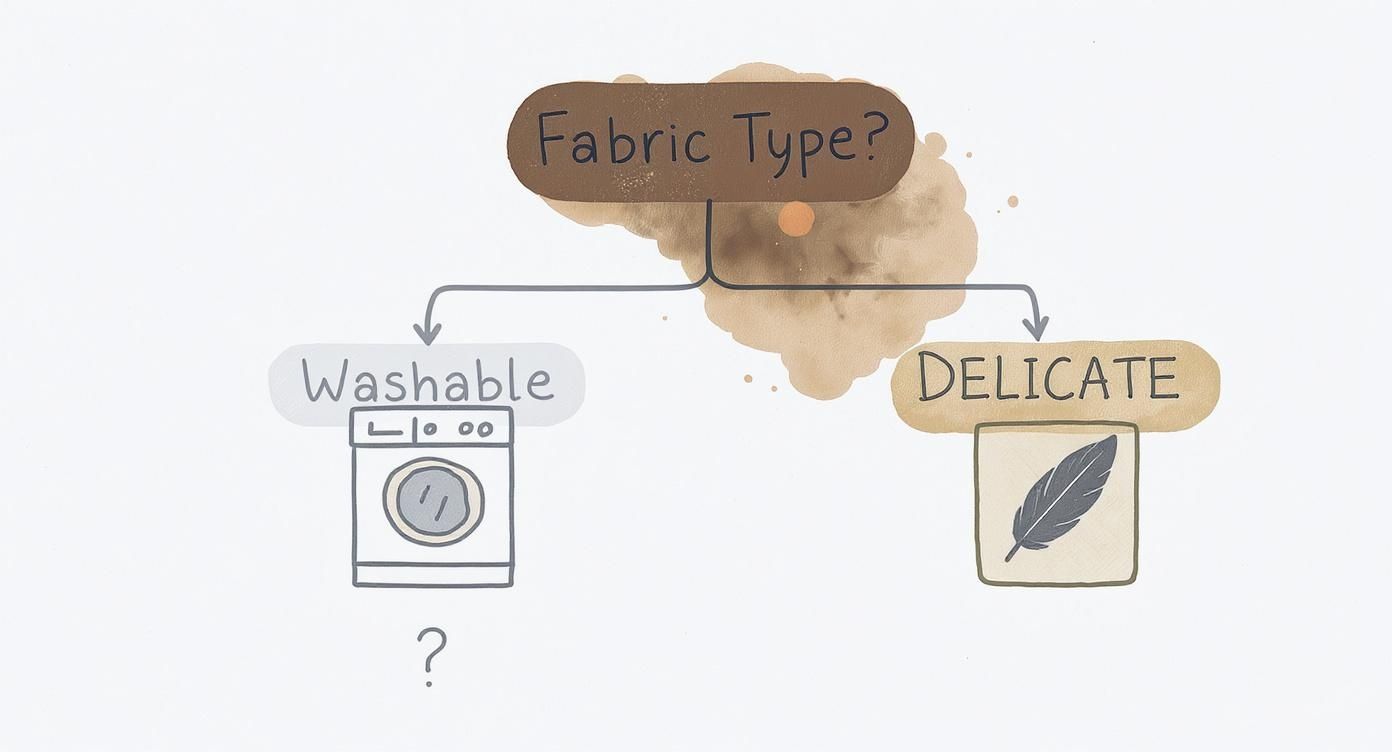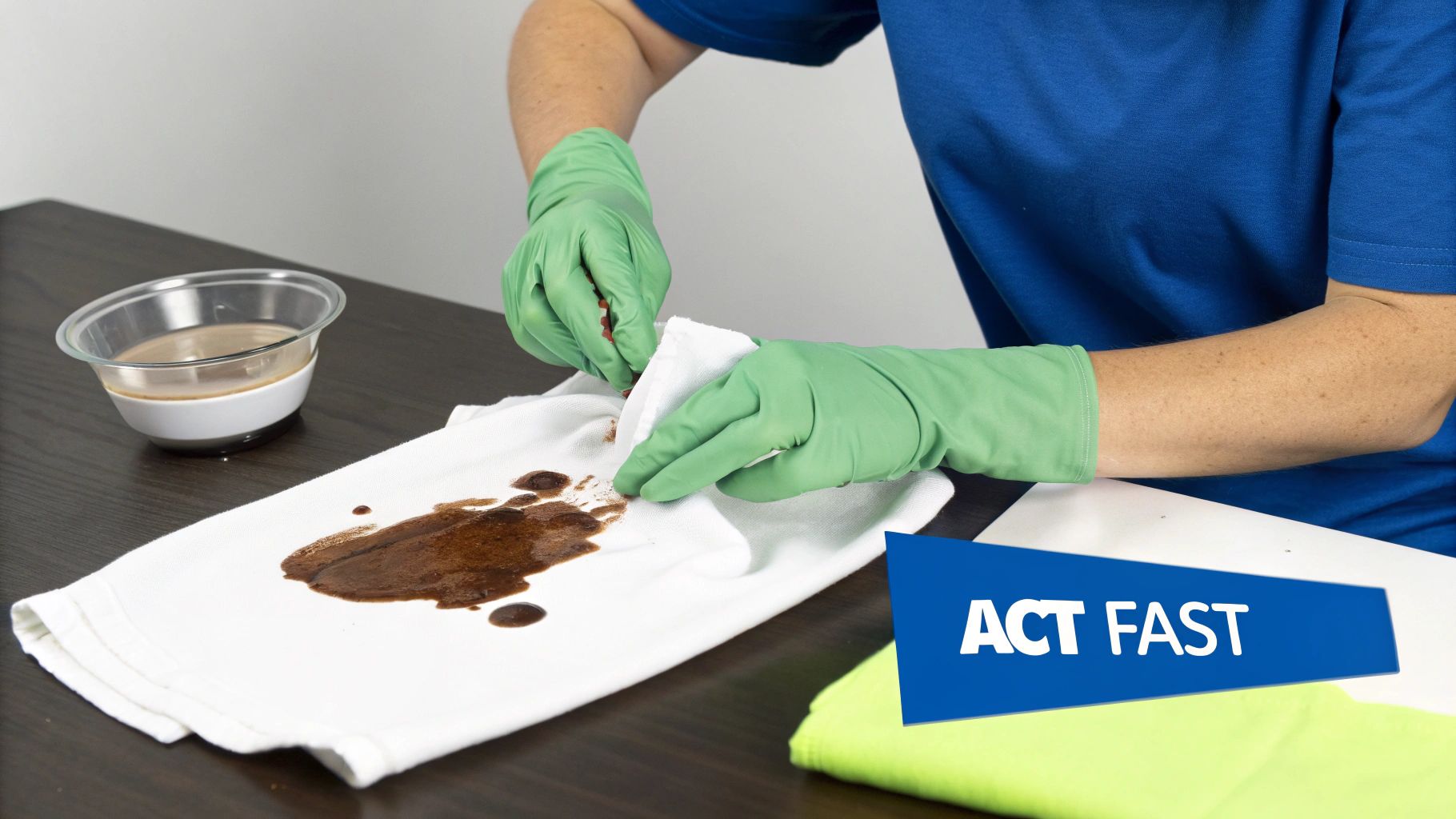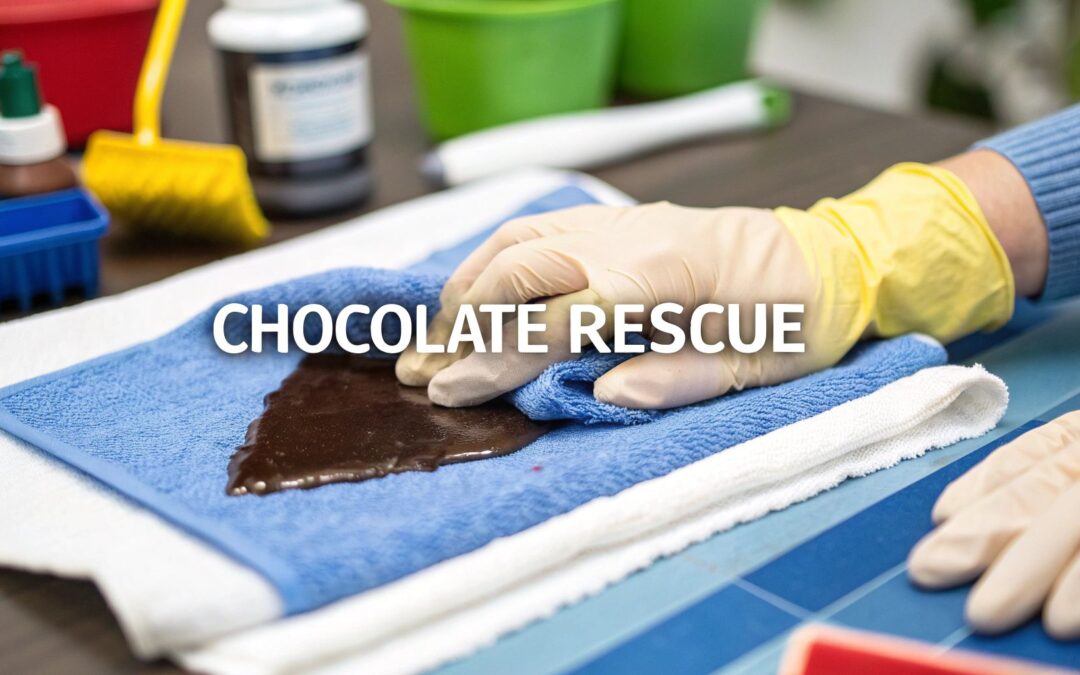Knowing how to get chocolate stains out of anything starts with one simple rule: act fast.
The trick is to scrape off any excess chocolate right away, then flush the stain from the back with cold water. This simple move stops it from setting deep into the fabric fibres.
Your First Move Against Chocolate Stains
A dropped piece of chocolate cake on a new shirt or a smear of ice cream on the couch can feel like a disaster, but how you react in those first few minutes makes all the difference.
Chocolate is a complex stain. It's a combination of oils (from cocoa butter), solids (like cocoa powder), and often dyes that all work together to grip onto fibres. This is exactly why a simple rinse with water often isn't enough to get the job done.
Understanding what you're up against is the key to removing it. The oily part needs something that can cut through grease, while the solid bits need to be gently lifted away without being rubbed further in. Moving quickly stops these components from making themselves at home permanently.
Immediate Action is Crucial
No matter the surface—a shirt, the couch, or the carpet—your first steps are always the same.
Australian laundry expert Nicole Gibson says the most effective approach is to scrape away any solid chocolate immediately before you even think about treating the stain itself. She recommends following this with a cold water rinse from behind the fabric. Why? Because this pushes the stain out, not further in. From there, you can move on to common household items like dishwashing liquid or a DIY stain remover. You can find more of her expert tips on how to handle chocolate mishaps at home.
This infographic gives you a quick decision tree to help you choose the right initial approach based on the fabric you're dealing with.

As the visual guide shows, figuring out if a fabric is washable or delicate is the very first, and most important, step in your stain-fighting strategy. This simple decision dictates the entire cleaning process that follows.
Key Takeaway: Always, always use cold water for the initial treatment of a chocolate stain. Hot water will essentially "cook" the protein in the chocolate, setting the stain permanently and making it nearly impossible to remove. This is the single biggest mistake people make.
Saving Your Wardrobe from Chocolate Stains

Clothing seems to be the first casualty in any chocolate-related incident. It could be a rogue drop of chocolate milk on a school uniform or a dessert mishap on your favourite blouse. Whatever the scenario, knowing how to tackle a chocolate stain can save your garments from an early retirement.
The good news? Most chocolate stains are entirely removable if you know the right steps.
But before you reach for any cleaning solution, your first and most critical move is to check the garment’s care label. This small tag is your roadmap, telling you exactly what temperatures and products the fabric can safely handle. Ignoring it is a fast track to turning a small stain into a permanent problem or even ruining the clothing itself.
The First Response for Fabric Stains
Once you’ve read the care instructions, your immediate goal is to get rid of any excess chocolate. If it’s solid, gently scrape it off with the edge of a spoon or a dull knife.
Dealing with a gooey, melted mess? Here's a clever trick: pop the garment in the freezer for about 15 minutes. This hardens the chocolate, making it much easier to flake off without smearing it deeper into the fabric.
After removing the solids, turn the garment inside out. You’ll want to flush the stain from the back by running cold water through it. This technique pushes the chocolate particles out of the fibres instead of driving them further in. Never use hot water at this stage; it will cook the proteins in the stain, setting it for good.
Pre-Treating for the Best Results
Pre-treating is the secret to completely erasing a chocolate stain. You have a few great options, and you probably already have them in your home.
-
Liquid Laundry Detergent: A good quality liquid detergent is designed to break down oils and proteins. Just apply a small amount directly to the stain and gently rub it into the fabric with your fingers or a soft-bristled toothbrush.
-
Dishwashing Liquid: Your standard dish soap is a fantastic degreaser. Its formula is made to cut through food oils, which makes it a powerful ally against the cocoa butter in chocolate.
-
Milk: It might sound a bit strange, but the enzymes in milk can help break down chocolate. Pour a little milk onto the stain and let it soak for about 10 to 15 minutes before rinsing. This is a gentle option that works well for more delicate fabrics.
Whichever pre-treatment you choose, let it sit on the stain for at least 15 minutes. This gives it time to work its magic. For really stubborn or dried-on stains, you can let the garment soak in a basin of cold water after applying the treatment.
Pro Tip: When working the pre-treatment into the fabric, always use a gentle circular motion. Scrubbing too aggressively can damage the fibres, especially on delicate materials like silk or wool, and might just spread the stain.
The Wash Cycle and Final Checks
After pre-treating, it’s time to wash the garment. Just follow the instructions on the care label, using the warmest water temperature recommended for that specific fabric. A warm or hot wash will help dissolve any oily residue the pre-treatment has loosened up.
Now for the most important step of all. After the wash cycle is done, do not put the garment in the dryer until you are 100% certain the stain is gone. The intense heat from a dryer will set any faint, lingering stain, making it permanent.
Instead, hold the damp garment up to a bright light and inspect the area closely. If you can still see any trace of the chocolate, simply repeat the pre-treatment and washing process. Only when the stain has completely vanished should you dry the item as you normally would. A little patience here is the key to saving your wardrobe from even the most daunting chocolate stains.
Lifting Chocolate from Carpets and Rugs

A dropped brownie or a tipped-over mug of hot chocolate on the living room rug can feel like a major disaster. Unlike clothing, you can't just toss a carpet into the wash, but the situation is far from hopeless. Tackling stains on carpets and rugs just requires a bit more patience and a slightly different method to avoid making the problem worse.
Your first instinct might be to scrub furiously, but that’s the biggest mistake you can make. Rubbing a chocolate stain only grinds the oily, pigmented mixture deeper into the carpet fibres, making it significantly harder to remove later. Instead, the golden rule is to blot, don't rub. This technique gently lifts the stain out rather than spreading it around.
The Initial Cleanup Process
Before you even think about applying cleaning solutions, you need to get rid of the excess chocolate. If the stain is still wet and gooey, gently scrape up as much as you can using a spoon or the dull edge of a butter knife. Always work from the outside of the stain inward to stop it from getting any bigger.
If the chocolate has already dried, that's even better. It might feel counterintuitive, but dried chocolate is much easier to manage. You can simply break up the hardened pieces and vacuum them up thoroughly. This step is crucial because it removes all the solid particles before you introduce any liquid, which could turn them into a muddy mess.
Expert Tip: Always test any cleaning solution on an inconspicuous spot of your carpet first, like inside a wardrobe or under a big piece of furniture. This quick check ensures the solution won't cause discolouration or damage to your carpet fibres.
Creating a DIY Cleaning Solution
You don't need harsh chemicals to effectively tackle a chocolate stain on your carpet. A simple, homemade solution is often all that's required to break down the oils and lift the colour right out.
Here’s a simple and effective recipe I've used countless times:
-
Mix one tablespoon of white vinegar with two cups of lukewarm water.
-
Add one tablespoon of clear, unscented dishwashing liquid.
-
Stir the mixture gently to combine everything without creating a mountain of foam.
This combination works wonders. The dish soap is a powerful degreaser that gets to work on the cocoa butter, while the white vinegar helps break down the rest of the stain's components.
Applying the Solution and Rinsing
Once your solution is ready, dip a clean, white cloth into it. You want the cloth to be damp, not sopping wet. Gently blot the chocolate stain, again working from the outer edges toward the centre. You'll start to see the chocolate transferring from the carpet to your cloth.
Keep turning the cloth to a clean section as you work to avoid re-depositing the stain back onto the carpet. Just be patient and continue this blotting process until the stain is gone.
After the stain is lifted, it's vital to "rinse" the area. Pour a small amount of plain cold water onto a fresh cloth and blot the spot to remove any soapy residue. Any soap left behind can attract dirt over time, creating a new, dark patch.
Finally, place a thick, dry towel over the damp area and press down firmly—you can even stand on it—to absorb as much moisture as possible. Let the spot air dry completely. With this careful method, you can lift that chocolate stain and leave your carpet looking spotless.
Cleaning Chocolate Stains on Furniture
A chocolate mishap on a couch, armchair, or mattress is a whole different ball game. You can’t just toss it in the wash. Furniture upholstery demands a more careful touch, with the main goal being to use as little moisture as possible to sidestep water damage, mould, or mildew.
Before you even think about cleaning, the most important thing you can do is find the cleaning tag. This little label, usually tucked away along a seam or under a cushion, holds the key to safely treating your furniture. It’ll have a code that tells you exactly what you can—and can't—use on the fabric.
Decoding Your Furniture Cleaning Codes
Trust me, you don’t want to skip this step. Understanding these codes is the difference between a successful clean and a permanent disaster. Using the wrong cleaner can bleach your fabric, ruin the fibres, or leave a mark worse than the original stain.
Here’s a quick rundown of what those letters mean:
-
W: Stands for "Water-based cleaner." Good news! You can safely use water and water-based cleaning solutions. This is the most common and easiest type of upholstery to clean.
-
S: This means "Solvent-based cleaner" only. Keep water away. You'll need a specific dry-cleaning solvent for any spot treatments.
-
SW or S/W: This is the most flexible option, meaning you can use either a water-based cleaner or a solvent cleaner.
-
X: This is the most restrictive code. It means you can only clean the item by vacuuming or light brushing. No water, no solvents. Game over.
Most furniture sold in Australia will have one of these tags, so take a minute to find it. It’s the single best way to protect your investment.
A Gentle Method for Fabric Upholstery
Once you've confirmed your furniture is good to go with water (Code 'W' or 'SW'), you can get to work on that chocolate stain. The secret here is to be stingy with the liquid.
First up, gently scrape off any solid chocolate chunks with a dull knife or the edge of a credit card. If the chocolate has melted into a gooey mess, harden it first by placing a plastic bag filled with ice cubes over it for a few minutes. That'll make it much easier to lift off.
Next, whip up a simple cleaning solution by mixing a few drops of clear dish soap into a cup of cool water. Use a whisk to agitate the mixture until you have a good amount of foam on top.
Crucial Tip: You’re only going to use the foam—not the liquid. Applying just the suds introduces minimal moisture, which is exactly what you want for upholstery. This technique cleans the surface without soaking the padding underneath, preventing those dreaded water rings and potential mould growth.
Scoop up some foam with a clean, soft cloth or a soft-bristled brush. Work gently from the outside edge of the stain inwards, which stops you from accidentally making it bigger.
Rinsing and Drying the Area
After working the suds into the stain, it's time to "rinse." Lightly dampen a separate clean cloth with plain cold water and blot the area to lift the soap. You’ll probably need to repeat this a few times with a fresh part of the cloth to get all the residue out.
Finally, press a dry towel firmly onto the spot to soak up as much moisture as possible. Then, just let it air dry completely. Whatever you do, don't use a hairdryer. The heat can set any stain remnants you might have missed.
For older or more stubborn stains, you might need to pre-soak the area to break down the oily components before cleaning. As noted by Australian experts, strategies for removing chocolate often depend on the fabric type and the age of the stain. You can explore more of these professional techniques from Steam Clean Team Australia.
Tackling Tricky Materials Like Leather
When chocolate finds its way onto delicate surfaces like leather, suede, or anything labelled 'dry clean only', the usual cleaning rules don't apply. These materials demand a more specialised and gentle touch to prevent permanent damage like water spots, discolouration, or a ruined texture. It’s less about aggressive scrubbing and more about a slow, careful process.
Successfully removing chocolate from these items means putting the safety of the material first. If you rush in with the wrong products, you can quickly turn a small, fixable stain into a costly disaster.
Treating Stains on Leather
Leather might be durable, but it's also porous. Harsh cleaners can easily strip it of its natural oils, leading to cracking and fading. So, when you're faced with a chocolate stain on a leather couch or jacket, the goal is to create a mild solution that cleans without causing harm.
First, gently lift off any solid bits of chocolate with the edge of a spoon or a dull knife. Next, mix a few drops of a pH-neutral soap (saddle soap is ideal, but a mild dish soap works too) into a small bowl of lukewarm water. You're not looking for a watery solution; you want to whip it up into a sudsy foam.
Pro Tip: For leather, you'll be using only the foam, not the liquid. Dip a soft, clean cloth into the bowl, scoop up just the suds, and work it into the stain using a gentle, circular motion. This technique minimises moisture and is your best defence against leaving water marks.
Once the stain is gone, wipe the area with a separate, slightly damp cloth to clear away any soap residue. To finish, buff the spot with a dry, soft towel. It’s always a good idea to follow up with a good leather conditioner to restore moisture and protect the finish. This careful process is hands-down the safest way to get rid of the stain without hurting the material.
Handling Suede and Delicate Fabrics
Suede and 'dry clean only' items are even trickier. For suede, water is the enemy. Your best bet is to wait for the chocolate to dry and harden completely. Once it’s solid, you can gently flake off the larger pieces. For any powdery residue left behind, use a suede brush or even a clean pencil eraser to lightly buff it away.
When it comes to 'dry clean only' clothes, your options at home are pretty limited, but you can still do some effective damage control. Gently scrape off the excess chocolate, then lightly blot the stain with a clean, dry cloth to soak up any oils. The key here is to avoid using any water or cleaning solutions.
This simple first step can make a huge difference for the professional cleaner, who has the right solvents to finish the job safely. Think of your role as containing the mess until an expert can take over.
Common Questions About Chocolate Stains
Even with the right techniques in your back pocket, some chocolate stain situations can leave you feeling a bit stumped. When you're figuring out how to remove chocolate stains, a few questions tend to pop up time and time again.
Getting clear, straightforward answers can be the difference between a successful clean and a permanent mark. So, let’s tackle some of the most common dilemmas people face when fighting off a chocolate mishap. This will help you approach any stain with confidence, no matter how stubborn it seems.
Can I Use Hot Water on a Chocolate Stain?
This is probably one of the biggest and most common mistakes you can make. You should absolutely avoid using hot water on a fresh chocolate stain. The heat will essentially "cook" the proteins in the chocolate, causing them to set and bind permanently with the fabric fibres.
Always start with cold water. It helps harden any leftover chocolate, making it easier to scrape off, and it begins flushing the stain out without setting it. You should only think about using warm or hot water during the final wash cycle in your machine, and only after you’ve successfully pre-treated and removed the visible parts of the stain. Even then, it’s a good idea to double-check the garment's care label to make sure it can handle higher temperatures.
What If the Chocolate Stain Has Already Dried?
A dried-on stain can look intimidating, but it's definitely not a lost cause. In some ways, a dried stain is actually easier to handle than a gooey, fresh one because you can remove the solid bits without smearing them everywhere.
First, scrape off as much of the flaky, dried chocolate as you can. A dull knife or the edge of a credit card works perfectly for this. Next, apply a small amount of liquid laundry detergent or dish soap directly onto the stain. Let it sit for at least 15 minutes to really penetrate the fibres and start breaking down the set-in oils and pigments.
For really stubborn dried stains on durable fabrics like cotton or denim, soaking the item can be a total game-changer. After applying your pre-treatment, submerge the garment in a basin of cold water with a bit more detergent or a specialised stain remover for 30 minutes before you chuck it in the wash.
Are Homemade Stain Removers Really Effective?
Yes, homemade solutions can be surprisingly effective, particularly on fresh stains. Common household items are a convenient and budget-friendly first line of defence when disaster strikes.
-
Bicarb Soda and Water: A simple paste made from bicarb soda and water can be gently worked into a stain to help lift it from the fabric.
-
White Vinegar and Dish Soap: A mixture of diluted white vinegar with a few drops of dish soap works well to break down both the tannin and the oily parts of the stain.
The big advantage here is that you probably have these ingredients in your pantry, ready for immediate action. But it's also important to recognise their limits. Commercial stain removers are formulated with specific enzymes designed to target and dismantle the complex proteins and fats found in things like chocolate. For older, darker, or more severe stains, a high-quality commercial product often provides the extra grunt needed to get the job done right.
When DIY methods just aren't cutting it, or you're dealing with delicate carpets and upholstery, getting a professional in is your best guarantee. Right Price Carpet Cleaning uses powerful, truck-mounted steam cleaning equipment to safely and effectively remove even the most stubborn stains, restoring your items and giving you peace of mind. Get an instant quote and see how we can help at https://rightpricecarpetcleaning.com.au.





Recent Comments